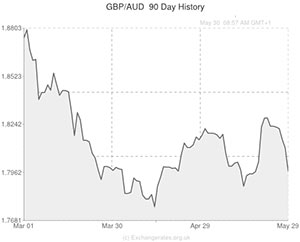
The GBP to AUD pairing opened European trading in a weaker position as the appeal of the Australian Dollar was boosted by domestic data and investors lost interest in a flagging Pound.
Yesterday the Pound slipped against almost all of its currency counterparts and fell to a six-week low against the US Dollar as a result of investors betting that the assets’ recent rally had been overdone.
During the Australasian session the ‘Aussie’ extended gains against Sterling as a report showed a 2.9 per cent month-on-month increase in Australian new home sales.
This followed a 0.2 per cent MoM climb in March.
In the opinion of an economist with Australia’s Housing Industry Association; ‘A housing recovery generates increased demand for a number of areas of the retail sector: furnishings and fittings for example; electronics to an extent. So we really do have quite a broad reach for the housing recovery going on in the rest of the economy, and also it’s a tick in the box for employment as well.’
He added; ‘There does seem to be a fairly widespread acceptance at the moment that interest rates are unlikely to go down again, but there unlikely to go up in the short-term either.’
The Australian Dollar was also supported as the nation’s capital expenditure report showed stronger-than-expected investment in manufacturing.
However, private capital expenditure was down by 4.2 per cent in the first quarter of the year, a steeper decline than the 1.9 per cent drop expected.
The figure for the fourth quarter was positively revised to a decline of 4.5 per cent.
Sterling remained softer against its peers even after a Bank of England official intimated that interest rates should be increased sooner rather than later.
During an interview policymaker Martin Weale asserted; ‘If you want to have baby steps, you do have to start sooner.’
However, Weale did add that he believed the BoE could hold off hiking rates for a little longer, commenting; ‘How long that ‘bit longer’ will be I’m not sure, but the best judgement I can have is that it’s not so urgent it needs doing now.’
The Pound came under additional pressure on Thursday as the Lloyds’ business barometer declined from 66 to 41 in May.
With Australia’s private sector credit report due out on Friday more Pound to Australian Dollar movement could occur before the weekend.
Pound to Australian Dollar Updated: 30/05/2014
GBP to AUD advances occurred overnight in response to surprisingly upbeat UK confidence data.
The GfK consumer sentiment index for May advanced to 0 from -3 instead of rising to -2 as expected.
Given that this week’s other UK reports (including mortgage approval and reported sales data) have come in below forecasts, this was a pleasant surprise.
The index now stands at a nine-year high.
Five sub-indicators are used to calculate the confidence measure and all expanded this month.
The measure of the economic situation rallied by 8 points over the month, with the future situation gauge advancing 12 points.
GfK’s Managing Director of social research Nick Moon said this of the report; ‘The real driver of the increase is people’s assessment of the general economic climate […] people’s verdicts of their own circumstances were less positive.’
Separate UK data showed an increase in UK house prices.
The Hometrack Ltd report detailed a 0.5 per cent increase in house prices in May. On the year house prices were up 6.1 per cent.
As concern that the UK’s housing market is overheating is one of the major arguments for the Bank of England increasing interest rates, this report helped modestly hike bets for a rate rise.
The Pound consequently advanced modestly on the Australian Dollar, although gains were limited by the news that Australian private sector credit increased by 0.5 per cent in April, month-on-month, more than the 0.4 per cent gain anticipated.
Australian Dollar (AUD) Exchange Rates
[table width=”100%” colwidth=”50|50|50|50|50″ colalign=”left|left|left|left|left”]
Currency, ,Currency,Rate ,
Australian Dollar, ,US Dollar, 0.9306,
,US Dollar, 0.9306,
Australian Dollar, ,Euro, 0.6838,
,Euro, 0.6838,
Australian Dollar, ,Pound, 0.5558,
,Pound, 0.5558,
Australian Dollar, ,New Zealand Dollar, 1.0968,
,New Zealand Dollar, 1.0968,
US Dollar, ,Australian Dollar, 1.0734,
,Australian Dollar, 1.0734,
Euro, ,Australian Dollar, 1.4615,
,Australian Dollar, 1.4615,
Pound Sterling, ,Australian Dollar, 1.7993,
,Australian Dollar, 1.7993,
New Zealand Dollar, ,Australian Dollar, 0.9120,
,Australian Dollar, 0.9120,
[/table]

Comments are closed.